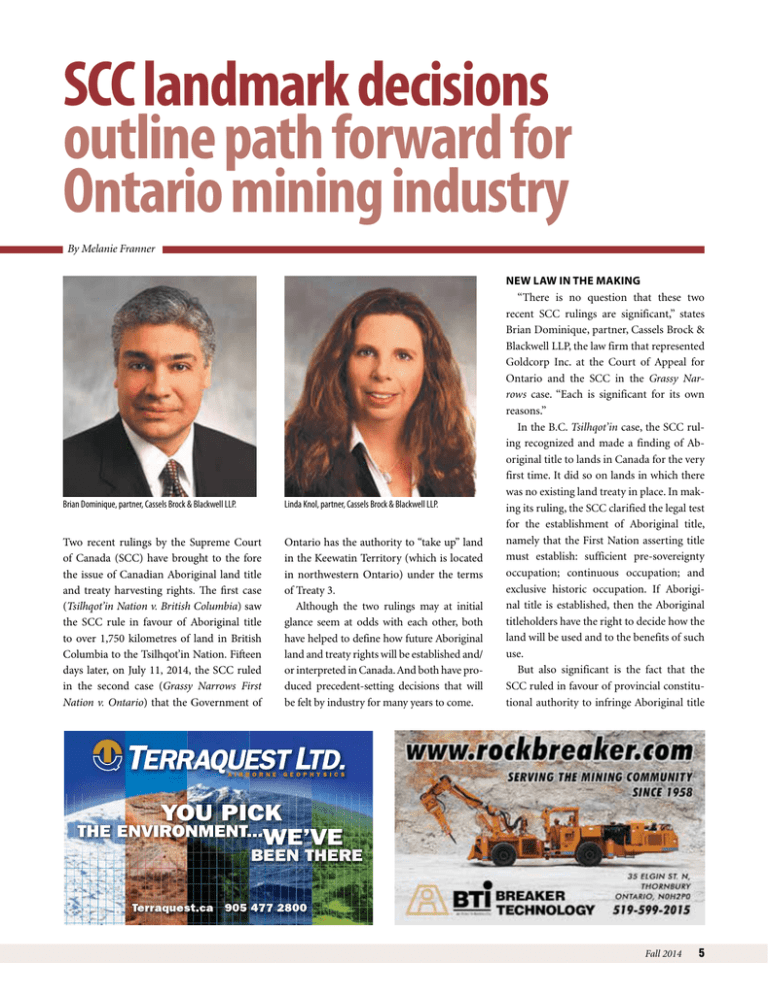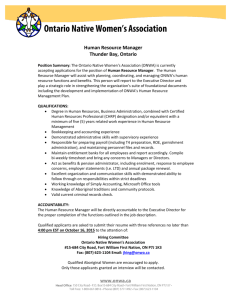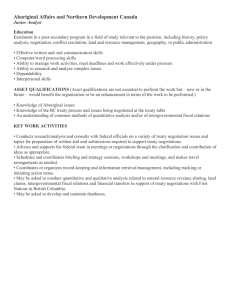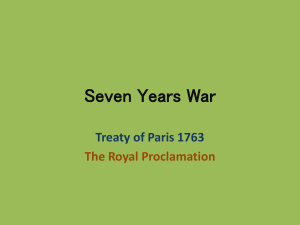
SCC landmark decisions
outline path forward for
Ontario mining industry
By Melanie Franner
Brian Dominique, partner, Cassels Brock & Blackwell LLP.
Linda Knol, partner, Cassels Brock & Blackwell LLP.
Two recent rulings by the Supreme Court
of Canada (SCC) have brought to the fore
the issue of Canadian Aboriginal land title
and treaty harvesting rights. The first case
(Tsilhqot’in Nation v. British Columbia) saw
the SCC rule in favour of Aboriginal title
to over 1,750 kilometres of land in British
Columbia to the Tsilhqot’in Nation. Fifteen
days later, on July 11, 2014, the SCC ruled
in the second case (Grassy Narrows First
Nation v. Ontario) that the Government of
Ontario has the authority to “take up” land
in the Keewatin Territory (which is located
in northwestern Ontario) under the terms
of Treaty 3.
Although the two rulings may at initial
glance seem at odds with each other, both
have helped to define how future Aboriginal
land and treaty rights will be established and/
or interpreted in Canada. And both have produced precedent-setting decisions that will
be felt by industry for many years to come.
New Law in the Making
“There is no question that these two
recent SCC rulings are significant,” states
Brian Dominique, partner, Cassels Brock &
Blackwell LLP, the law firm that represented
Goldcorp Inc. at the Court of Appeal for
Ontario and the SCC in the Grassy Narrows case. “Each is significant for its own
reasons.”
In the B.C. Tsilhqot’in case, the SCC ruling recognized and made a finding of Aboriginal title to lands in Canada for the very
first time. It did so on lands in which there
was no existing land treaty in place. In making its ruling, the SCC clarified the legal test
for the establishment of Aboriginal title,
namely that the First Nation asserting title
must establish: sufficient pre-sovereignty
occupation; continuous occupation; and
exclusive historic occupation. If Aboriginal title is established, then the Aboriginal
titleholders have the right to decide how the
land will be used and to the benefits of such
use.
But also significant is the fact that the
SCC ruled in favour of provincial constitutional authority to infringe Aboriginal title
Fall 2014
5
and treaty harvesting rights if the infringement can be justified. This ruling reversed
previous case law that had recognized that
right solely to the federal government.
“The test for determining if a province
can infringe upon Aboriginal title or treaty
harvesting rights requires the government
to demonstrate a compelling and substantial objective and that its actions are consistent with the fiduciary duty it owes to the
affected First Nations,” explains Linda Knol,
partner, Cassels Brock & Blackwell LLP.
6
Ontario Mineral Exploration Review
“Proof that the government’s actions are
consistent with its fiduciary duties involves
the following considerations: the infringement must be necessary to achieve the government’s objectives, the government must
go no further than necessary to achieve its
objectives, and the benefits must not outweigh the adverse affects on the Aboriginal
interest.”
The government’s infringement can be
justified, in principle, for the development
of agriculture, forestry, mining, hydroelec-
tric power, general economic development,
protection of the environment or endangered species, the building of infrastructure,
and the settlement of foreign populations to
support these objectives.
Infringement or
Adverse Effects
Between the two decisions, the SCC has
outlined how the government is to address
Aboriginal title and treaty harvesting rights
under various scenarios, including cases
where Aboriginal title has been established,
cases where Aboriginal title has been asserted but not yet established, and cases where
the First Nation has surrendered title under
a treaty but has retained the right to harvest
over any surrendered land not taken up by
the Crown.
In each of these scenarios, the common
factor is the duty of the Crown to consult
with and potentially accommodate any First
Nation whose interests may be affected by a
proposed project or the taking up of land.
These “good faith” consultations are mandatory.
In cases where Aboriginal title has been
established, any taking up of land (by, for
example, granting a mining lease or approving a gas pipeline) without the consent of
the Aboriginal titleholder will constitute an
infringement of the Aboriginal titleholder’s
rights that must be justified by the Crown.
What isn’t quite as concrete is the definition of “infringement” in the context of
treaty harvesting rights.
Knol notes that in the Grassy Narrows
ruling, the SCC confirmed its 2005 decision in Mikisew Cree First Nation v. Canada
that the Crown’s authority to take up treaty
lands is not unconditional.
“Ontario has the duty to consult with
First Nations and to accommodate their
interests where appropriate, and Ontario
cannot take up so much surrendered treaty
land that the First Nation’s right to harvest in their traditional territories becomes
meaningless,” she states. “However, the test
that the courts will apply to determine the
point at which a treaty harvesting right becomes meaningless is still unclear.”
Dominique notes that the rulings by the
SCC are already being interpreted by interested parties in different ways. “I think
we’ll see at least another 20 years of litiga-
tion on the issue of infringement before a
happened if the SCC didn’t find in favour
full framework of basic principals are estab-
of Ontario in order to understand the sig-
lished,” he says. “The Aboriginal side is likely
nificance of the decision,” says Knol. “If the
to approach the requirements of consulta-
SCC had ruled the other way, then all of the
tion as having to meet the higher standard
land-use decisions that Ontario made over
of infringement in all instances, rather than
the last 100 years in the Keewatin Territo-
the standard required to be met for an ad-
ry, such as the grant or issuance of mining
verse affect.”
leases and forestry licences and other interests in land, would have been called into
Canada versus Ontario
question as it would have been uncertain if
The Grassy Narrows decision was significant for a couple of other important
Ontario had the authority to grant or issue
them.”
reasons. For one, it put to bed the question
Had the SCC ruled against Ontario in
of whether Canada alone is responsible for
this case, it would also have set a precedent
fulfilling the Treaty 3 promises. Canada was
for other treaties and other provincial gov-
the Crown signatory to the treaty, which
ernments.
was signed in 1873, but it subsequently an-
“Had the ruling gone the other way, not
nexed that land to Ontario. The SCC ruled
only would Treaty 3 have to be re-written, in
that, as Crown representatives, both Canada
essence, but it would put into question the
and Ontario are responsible for fulfilling
terms of several of the other land treaties
the Treaty 3 promises within their respec-
across the country,” adds Dominique.
tive spheres of jurisdiction.
“In the Grassy Narrows SCC ruling, I
think one has to look at what would have
Moving Forward
Although the two recent SCC decisions
have gone a long way in defining Aboriginal
land title and treaty rights, they have also
opened the door to further interpretation
that will more than likely require additional
court cases, appeals and potentially, SCC
rulings.
As to how industry will deal with these
issues, only time will tell. Until then, the status quo remains.
“The fact that Ontario is substantially a
treaty province is an obvious benefit,” states
Dominique. “There may be some uncertainties in the future, but on a day-by-day
basis, it’s kind of business as usual for industry. Ontario mining companies, for the
most part, understand the need to consult
with and accommodate the interests of First
Nations in good faith. They’ve been doing
that already. At some point, however, the
parties are going to come to loggerheads
about how to determine the distinction between impairment and infringement. But
until then, it’s business as usual, as industry
and Aboriginal peoples have come to know
it.”
We dig mining.
”Dirt Law.” Those two words cover
a lot of ground – claims, permits,
treaty negotiations, development
deals, working with vendors, with
governments, you name it. It’s the
law of day-to-day mine operations.
To make sure it’s done right, here
are two more words: Cassels Brock.
casselsbrock.com/mining
© 2014 Cassels Brock. All rights reserved.
Cassels Brock - December 2, 2014
Ontario Mineral Exploration Review Magazine
Half page horizontal - 7” x 4.625”
Submitted by: Heather Murray
hmurray@casselsbrock.com
416 869 5782 - fax 416 642 7137
Falleither
2014
Please PRINT a hard copy of the file and
FAX it or SCAN and EMAIL it back to me,
thanks!
7





